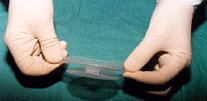 New
Hernia Repair Device Pioneered at Hernia Institute
New
Hernia Repair Device Pioneered at Hernia Institute
A new hernia repair system has been developed by Ethicon, a Johnson & Johnson subsidiary, with the assistance of Dr. Arthur I. Gilbert of the Hernia Institute of Florida and Professor Andrew Kingsnorth of Royal Liverpool University Hospital in England.
"Prolene (polypropylene) Hernia System," is a three-in-one mesh device made of polypropylene that surgeons can use to repair the most common types of abdominal wall hernias. Already, hundreds of surgeons around the world have been introduced to the new device and many surgeons have come to the Hernia Institute in Miami to be trained to use it.
"For those few of us who do nothing but hernia repair, we recognize variations in each hernia and can adjust our techniques to fit each patient's needs," said Dr. Gilbert, one of only 25 hernia specialists in the world. He has repaired more than 22,000 hernias at the Hernia Institute of Florida in Miami.
"There are more than 700,000 hernia repairs each year in the United States — the most common operation among men — and most of these are done by general surgeons who also do many other types of operations. This new device gives them a single technique which will enable them to do better repairs and achieve better outcomes," he said.
The typical hernia is a tear in the abdominal wall tissues that normally contain the abdominal organs. When an organ protrudes through the opening, it is felt as a bulge in the groin. In the past hernia repair was done by closing the hole with sutures. This means stretching surrounding muscle to make the repair. Dr. Gilbert, through years of study, realized that this created tension in the already-weakened tissues, leading to additional tears elsewhere as time went on.
In 1986 Dr. Gilbert developed a tension free repair technique utilizing polypropylene mesh which he carefully cut, folded, and inserted through the hernia, allowing it to unfold and patch the opening. In 1997 Dr. Gilbert helped Ethicon design its new hernia repair device. It produces a tension-free repair and the technique is easy to learn. It has resulted in fewer complications, less post-operative discomfort, and more rapid return to regular activities than older repairs.
Older methods of hernia repair have resulted in a 15% to 20% failure rate for primary hernias and up to 50% failure rate for recurrent hernias. Ethicon projects a failure rate of less than 1% for all surgeons who use the new device, which matches Dr. Gilbert's success over the years.
The new Prolene (polypropylene) Hernia System consists of two patches connected by a mesh cylinder. "It has double wafers of mesh, top and bottom layers covering the hernia on both sides like two slices of bread in a sandwich," Dr. Gilbert said. "I've already used this on more than 2,500 patients without a problem, and I feel certain this product will be a welcome improvement for surgeons who prefer to use a single device to perform open-mesh tension-free repairs."